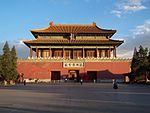Guanganmen incident
The Guang'anmen Incident (Japanese: 広安門事件, Hepburn: Kōanmmon Jiken), or Kuanganmen Incident, was an attack on the Japanese army by the National Revolutionary Army’s 29th Army that occurred on 26 July 1937 in the opening stages of the Second Sino-Japanese War in Beiping, now Beijing, which was the under the control of the Hebei–Chahar Political Council. It occurred following the Marco Polo Bridge Incident of 7 July, and the Langfang Incident of 25 July. At the time, the Chinese army was already amassing in large numbers at Baoding and Shijiazhuang in the southern half of Hebei and at Datong in Shanxi, and had the Japanese army enclosed on all side in the Fengtai District, while on the Japanese side, newly mobilized units of the Kwantung Army and the Japanese Korean Army were in the process of reaching the area of Tianjin and Beiping. The Kuanganmen Incident was an incident that occurred while the degree of tension between the two armies was increasing.
Excerpt from the Wikipedia article Guanganmen incident (License: CC BY-SA 3.0, Authors).Guanganmen incident
西华门大街, Dongcheng District Donghuamen (首都功能核心区)
Geographical coordinates (GPS) Address Nearby Places Show on map
Geographical coordinates (GPS)
| Latitude | Longitude |
|---|---|
| N 39.913888888889 ° | E 116.39166666667 ° |
Address
故宫 (紫禁城;北京故宫;北京故宫博物院)
西华门大街
100032 Dongcheng District, Donghuamen (首都功能核心区)
Beijing, China
Open on Google Maps











